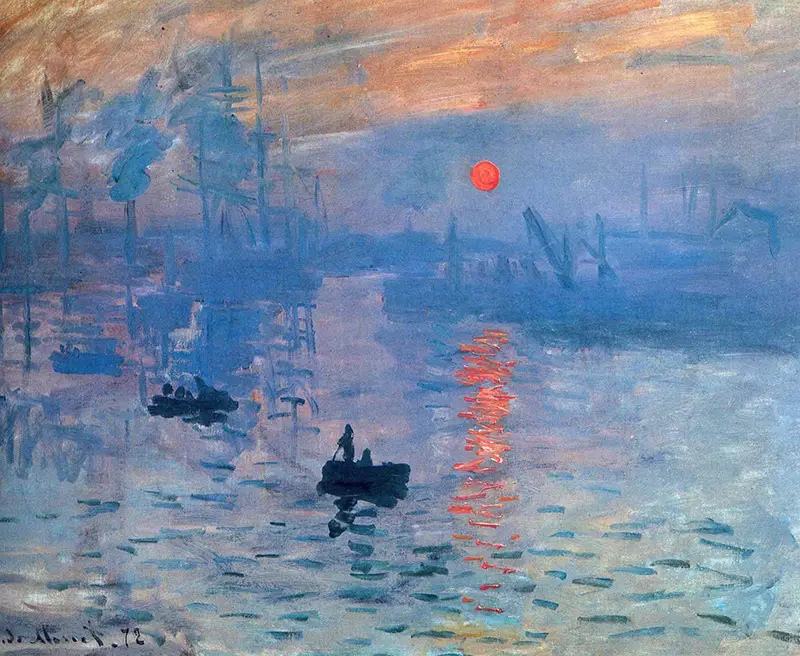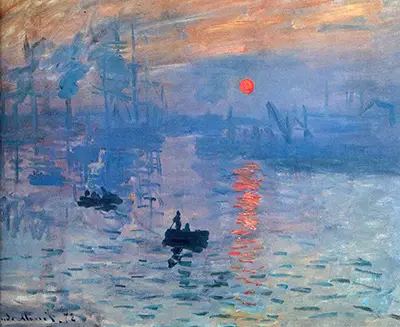Le Havre in Northwest France was Monet’s hometown and during 1872 he visited the area regularly. During these visits, he would paint scenes in the area, including the port.
There is a total of six canvases that depict the port in different ways; at dawn, during the day, at dusk, in the dark, from the water and from the viewpoint of his hotel room. The most famous in this series was ‘Impression, Sunrise’. This piece was painted from his hotel room just as dawn was breaking.
The painting made its debut onto the art scene alongside the work of 30 other artists in an exhibition that was initially called ‘Painters, Sculptors, Engravers etc. Inc.’. Amongst those exhibiting their work were Degas, Sisley, Renoir and Pissarro.
According to Monet, he gave the painting a title as he was asked to do so for the exhibition catalogue. In explanation of his title choice, he attributed his hazy painting style to using the term ‘Impression’ as he felt that the term ‘view’ was not an accurate reflection of the painting style. Therefore, he titled the piece 'Impression: Soleil Levant', or 'Impression: Sunrise'.
Some later said that he chose the title to avoid criticism from those who would say the painting lacked detail or appeared unfinished. Regardless of the title, the piece did receive criticism for exactly those reasons.
The term impressionism was not new and was used prior to Monet’s work, particularly to describe paintings from the Barbizon school. It was also a term associated with the work of Manet and Daubigny. The term was originally used as a way of describing the effects of the scene on a painter or the effect that paintings had on viewers.
Following the exhibition featuring Monet’s 'Impression, Sunrise', the term impressionism was applied in a different way. Louis Leroy reviewed the exhibition for the La Charivari newspaper and referred to it as the ‘Exhibition of the Impressionist’. His review described the style of work displayed in the exhibition as impressionism and described Monet’s work as representing this style perfectly. Thus, the movement of impressionism was born.
Criticism of the Painting
Following the exhibition, Monet’s work received very few reviews. In fact, just five reviews even mentioned his painting as other works exhibited had attracted more attention from the critics. The reviews mainly concentrated on the exhibition as a whole and the style of paintings displayed. Some, including Louis Leroy, ridiculed the style. Others supported the work and explained in the reviews that the artists were not painting landscapes; they were painting the impression that was given by the landscape.
Despite the initial criticism of his painting, modern art critics take a much more favourable view of his painting and it is often described as one of the best works of Monet. It is possible that changing attitudes towards artistic styles are the reason for these differences of opinions.
Prior to Monet, art was very traditional and artists depicted their subjects accurately and in detail. Between Monet’s 'Impression, Sunrise' and the works of modern artists, styles have changed dramatically with artists using unusual subjects and painting in an ever more abstract fashion.
While Monet was once seen as radical, his techniques are now simply seen as different rather than unique or shocking. It is possible that critics are now more open to the concept of new ideas and different styles than the critics at the time of the original exhibition of this work.

Subject and Interpretation
On first glancing at the painting, the three most prominent features of the painting are the bright sun and the two small fishing boats. On closer inspection, further fishing boats are seen in the background along with industrial landscapes.
There are several interesting points to note when studying this picture. First, the brightness of the orange sun against the grey background appears to make the sunset stand out in the painting. However, the sun is no brighter than any of the other colours used. In fact, if this painting is viewed in black and white, the sunrise becomes almost invisible. This is because of the way the human eye perceives luminance and colour.
The second interesting point to analyse is the background, which predominantly consists of steamships and smoke chimneys. Le Havre was a thriving port and some art historians claim that the prominence industry in this painting represents political implications. It is particularly interesting when you realise that the true scene that Monet could see when completing his painting included houses to the left side of the jetty but Monet chose to ignore these and not include them in his painting so as not to obscure the industrial aspect of the scene.
Some people view 'Impression, Sunrise' as an ode to poetry and light. The opinion of others is that the painting represents the power and beauty of France as the country revitalised itself following its defeat in the Franco-Prussian War of 1870-1871.
The style of this painting is far from the traditional styles used for landscape and seascape painting. The techniques used by Monet created a style that allowed an artist to express their expressions, beliefs and interpretations of what they could see rather than an accurate representation of the scene.
Monet used light and loose brush strokes that simply suggested the scene rather than exactly depicting what the eye could see. It is said that Monet worked at great speed on paintings in this style as though he was trying to capture the movement of the light as it happened.
When he painted 'Impression, Sunrise', Monet did not mix colours to create different hues. Nor did he wait for one layer of paint to dry before applying the next. Rather, he used natural colours in layers that each then mixed with the layer of paint below and the production of light, shade and colours happens directly on the canvas. A number of factors may impact on this process, such as temperature, humidity and wind, depending on the setting of the painting.
Also, Monet demonstrates a different attitude towards what he is painting in comparison to the work of other artists. Traditionally, artists had focused on form, structure and colour. For Monet, the primary focus was light and the way it interacted with the various elements of the landscape. He also concentrated on saturation and composition.
Impression, Sunrise was painted predominantly in varying shades of grey that were added in layers that give depth to the painting. It is this use of depth that creates a recognisable impression of Le Havre, despite the inaccuracies of the scene. Due to the choice of colours, there is not a clear and definite boundary between the sky and the water. Similarly, there is little definition between the outlines of subjects in the painting. This makes the background appear blended together and it is only when the painting is studied closely that individual features of the painting are clear.
Some people have described Monet’s work as playing with the eye rather than impressing the viewer. By this, the critics mean that it is interpreted differently from one person to the next and each person will notice something different the longer they look at the painting. The original image they see changes while they are looking at it and some people even claim to feel a sense of movement in the picture.
Negative critique has suggested the painting lacks shape, form and shade. Strictly speaking, this is not true as the form of the fishing boats and the sun are perfectly clear in their form. On closer inspection, it is also apparent that one of the fishing boats holds two people.
Although the background is abstract and somewhat open to interpretation, this does not necessarily mean there is no form, lines or shade. The style used simply means that greater personal interpretation and intellect are required to discern the various elements of the painting. As there is an element of ambiguity about the seascape, it requires a certain amount of subjective perception.
As a result, there is a certain timeless quality to the painting. Regardless of whether it was viewed it during the first exhibition or during the 21st century, it is possible for the viewer to place their own meaning and symbolism to the painting.
Viewing the Painting
Anyone who wants to see the painting for themselves will find 'Impression, Sunrise' exhibited at Musée Marmottan Monet in Paris, France. The museum is home to the largest collection of Monet’s work in the world. In addition to the work of Monet, the museum also displays the work of other impressionists and has collections devoted to Paul Marmottan and Berthe Morisot. These are all collections well worth viewing during a trip to Paris.


